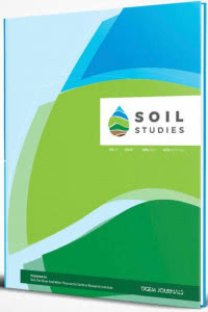Buğday Verimi ve Biyokütlesi ile Uzaktan Algılama Vejetasyon İndisleri Arasındaki İlişkilerin Tarımsal İklim Bölgeleri Bazında Değerlendirilmesi
Evaluation of the Relationships Between Wheat Yield and Biomass with Remote Sensing Vegetation Indices on the basis of Agricultural Climate Regions
Agricultural climate regions biomass, EVI, NDVI, yield,
___
Allen RG, Pereira LS, Raes D, Smith M (1998). Crop evapotranspiration: Guideline for computing crop water requirements.FAO No56. Araya A, Keesstra SD, Stroosnijder L (2010). “A new agroclimatic classification for crop suitability zoning in northern semi-arid Ethiopia”. Agric. Forest Meteorol. 150. 1057–1064. Balaghi R, Tychon B, Eerens H, Jlibene M (2008). “Empirical regression models using NDVI, rainfall and temperature data for the early prediction of wheat grain yields in Morocco”, International Journal of Applied Earth Observation and Geoinformation, 10, pp. 438–452. Bouma E (2005). Development of comparable agroclimatic zones for the international exchange of data on the efficacy and crop safety of plant protection products. OEPP/ EPPO. Bulletin OEPP/EPPO Bulletin. 35. 233– 238 Plant Protection Service. Geertjesweg 15. PO Box 9102. NL-6700 HC Wageningen (Netherlands). Caldiz DO, Haverkort AJ, Struik PC (2002). “Analysis of a complex crop production system in interdependent agroecological zones: a methodological approach for potatoes in Argentina”. Agric. Syst. 73. 297–311. FAO (1996). Agro-Ecologıcal Zoning Guidelines. Soil Bulletin. vol. 73. FAO. Rome. Fischer G, Shah M, Tubiello FN, Van Velhuizen H (2005). “Socio-economic and climate change impacts on agriculture: an integrated assessment. 1990–2080”. Phil. Trans. R. Soc. Lond. B 360. 2067–2083. Gallup JL, Sachs JD (2000). “Agriculture. climate. And technology: why are the tropics falling behind?”. Am. J. Agric. Econ. 82. 731–737. Geerts S, Raes D, Garcia M, Del Castillo C, Buytaert W (2006). “Agro-climatic suitability mapping for crop production in the Bolivian Altiplano: a case study for quinoa”. Agric. Forest Meteorol. 139. 399–412. Gouri V, Reddy DR, Rao SBSN, Rao AY (2005). Thermal requirement of rabi groundnut in southern Telengana zone of Andhra Pradesh. J. Agrometeorol..7: 90-94. Hutchinson MF (2000). ANUSPLIN version 4.1. User guide. center for resource and environmental studies, Australian National University, Canberra. Hutchinson MF (1995). Interpolating mean rainfall using thin plate smoothing splines. Int. J. Geogr. Info. Systems, 9: 385-403. Huete A, Didan K, Miura T, Rodriguez E P, Gao X, Ferreira L G (2002). Overview of the radiometricand biophysical performance of the MODIS vegetation indices. Remote Sens. Environ. 83, 195–213. Lu D, Mausel P, Batistella M, Moran E (2005). Landcover binary change detection methods for use in the moist tropical region of the Amazon. International Journal of Remote Sensing. Vol. 26. No. 1. pp. 101–114. Lusch D P (1999). Introduction to Environmental Remote Sensing: Michigan: Center for Remote Sensing and GIS. Kogan F (1994). NOAA plays leadership role in developing satellite technology for drought watch. Earth Observation Magazine. EMO Inc.. Littleton. CO. USA. pp. 18–20. Kouadio L, Newlands N K, Davidson A, Zhang Y, Chipanshi A (2014). “Assessing the Performance of MODIS NDVI and EVI for Seasonal Crop Yield Forecasting at the Ecodistrict Scale.” Remote Sensing 6: 10193–10214. doi:10.3390/rs61010193. Mcmaster G S, Wilhelm W (1997). Growing degreedays: one equation. two interpretations. Agric. For. Meteorol. 87(4):291-300. doi:10.1016/S0168-1923(97)00027-0. Minamiguchi N (2005). The Application of geospatial and disaster information for food insecurity and agricultural drought monitoring and assessment by the FAO GIEWS and Asia FIVIMS // Proceedings of the Workshop on Reducing Food Insecurity Associated with Natural Disasters in Asia and the Pacific. Bangkok. P. 20-21. Pertziger F, De Pauw E (2002). CLIMAP. An Excel-based software for climate surface mapping. ICARDA, Aleppo, Syria. Rouse J W, Haas R H, Schell J A, Deering DW (1973). Monitoring vegetation systems in the Great Plains with ERTS. Proceedings of the Third ERTS Symposium. NASA SP-351. Washington. DC. NASA. p. 309-317. Seppelt R (2000). Regionalised optimum control problems for agroecosystem management. Ecol. Model. 131. 121–132. Tucker C (1979). Red and photographic infrared linear combination for monitoring vegetation. Remote sensing of Environment. 8. 127- 150. Turkes M (1999). Vulnerability of Turkey to desertification with respect to precipitation and aridity conditions, Tr. J. Of Engineering and Environmental Science, 23 (1999) , 363- 380. TUBITAK. UN-DESA (2013). World Population Prospects: The 2012 Revision. United Nations Department of Economic and Social Affairs. Population Division. New York. http://esa.un.org/ unpd/wpp/index.htm. UNEP (1993). World atlas of desertification. The United Nations Environment Programme (UNEP), London. Zhang S, Lei Y, Wang L, Li H, Zhao H (2011). Crop Classification Using MODIS NDVI Data Denoised by Wavelet: A Case Study in Hebei Plain. China. Chin. Geogra. Sci. 2011 21(3) 322–333 doi: 10.1007/s11769-011-0472-2. Williams CL, Liebman M, Edwards JW, James DE, Singer JW, Arritt R, Herzmann D (2008). Patterns of regional yield stability in association with regional environmental characteristics. Crop Sci. 48. 1545-1559.- ISSN: 2146-7072
- Yayın Aralığı: Yılda 2 Sayı
- Yayıncı: Toprak Gübre ve Su Kaynakları Merkez Araştırma Enstitüsü
Jeotermal Kaynakların Tarımsal Sulama Suyu Kirliliği ve Kalitesi Üzerine Etkilerinin Belirlenmesi
Harun TORUNLAR, Murat Güven TUĞAÇ, Dilek KAYA ÖZDOĞAN, Gamze DEPEL, Nevzat DEREKÖY
Selçuk ÖZER, Ozan ÖZTÜRK, Ülviye ÇEBİ, Süreyya ALTINTAŞ, Engin YURTSEVEN
Türkiye’nin İller Bazında Kuraklık Değerlendirmesi
İlknur CEBECİ, Oğuz DEMİRKIRAN, Orhan DOĞAN, Kevser KARAGÖZ SEZER, Ödül ÖZTÜRK, Fatma ELBAŞI
Hatun BARUT, Sait AYKANAT, Elif HAKLI HEYBET, Salim EKER, İsmail ÇAKMAK
Bulanık Yapay Sinir Ağları ve Çok Katmanlı Yapay Sinir Ağları ile Günlük Buharlaşma Tahmini
Demet YILDIRIM, Bilal CEMEK, Erdem KÜÇÜKTOPCU
Mehmet Emin BİLGİLİ, Adil AKYÜZ
Samsun İli Sebze ve Meyve Üreticilerinin İyi Tarım Uygulamalarına (İTU) Yaklaşımı
Mehmet AYDOĞAN, Başak AYDIN, Necla TOPÇU, Yunus Emre TERZİ
Toprak pH’sını Etkileyen Bazı Materyallerin Hububat Tarımında Kullanımı
Kadir UÇGUN, Caner KELEBEK, Murat CANSU, Mesut ALTINDAL, Bilal YALÇIN
